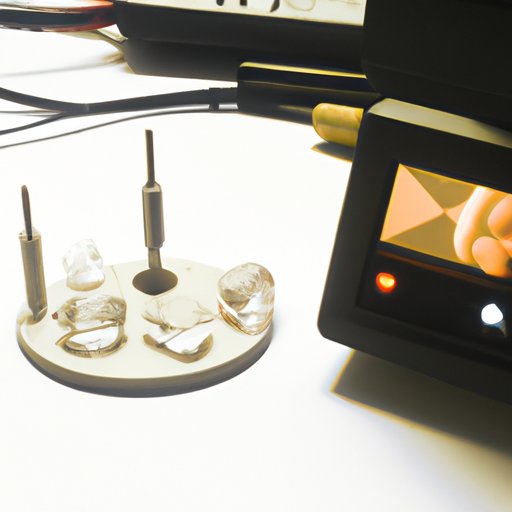Introduction
Diamonds are some of the most beautiful and valuable gems in the world. Authenticating their quality is essential for jewelers and consumers alike. But how do diamond testers work? This article will provide an overview of the science behind diamond testers and explore the different types available. You’ll also learn step-by-step how to use a diamond tester and get tips for testing your own diamonds at home.
Exploring the Science Behind Diamond Testers
To understand how diamond testers work, it’s important to first have an understanding of the properties that make diamonds unique. Diamonds are made of carbon atoms arranged in a tetrahedral lattice structure which gives them their hardness, durability and distinct sparkle. They also have a high refractive index, meaning they bend light more than other materials.
The scientific explanation of how diamond testers work is based on these physical characteristics. Different types of diamond testers measure different properties of diamonds to determine their authenticity. The two most common methods are thermal conductivity and electrical conductivity. Thermal conductivity testers measure the amount of heat a diamond absorbs and transfers. Electrical conductivity testers measure the resistance to electricity passing through a diamond. Refractive index testers measure the amount of light that passes through a diamond.
A Step-by-Step Guide to Using a Diamond Tester
Using a diamond tester is relatively simple, but there are a few steps you should take to ensure accurate results. Here’s a step-by-step guide to using a diamond tester:
1. Choose the right diamond tester. Not all diamond testers are created equal. It’s important to choose a tester that is designed specifically for the type of diamond you are testing (e.g., natural or synthetic). Also consider your budget and the accuracy ratings of the tester.
2. Prepare the diamond for testing. Before testing, make sure the diamond is clean and free of any dirt or debris that may interfere with the reading. Also, be sure to wear protective gloves to avoid any skin oils from affecting the results.
3. Conduct the test. Depending on the type of diamond tester you are using, follow the manufacturer’s instructions for placing the diamond in the tester and conducting the test. Some testers require the diamond to be placed in contact with a metal probe.
4. Interpret the test results. After the test is complete, the tester will display a “pass” or “fail” result. If the result is “pass,” the diamond is authentic. If the result is “fail,” the diamond is likely not a real diamond.

An Overview of the Different Types of Diamond Testers
There are three main types of diamond testers: thermal conductivity testers, electrical conductivity testers, and refractive index testers. Let’s take a closer look at each one:
Thermal Conductivity Testers. Thermal conductivity testers measure the amount of heat a diamond absorbs and transfers. They rely on the fact that diamonds are better thermal conductors than other materials. When a diamond is placed in contact with a metal probe, the probe will absorb heat from the diamond, giving an indication of its authenticity.
Electrical Conductivity Testers. Electrical conductivity testers measure the resistance to electricity passing through a diamond. When electricity passes through a real diamond, it will encounter less resistance than if it were passing through a fake diamond. By measuring this resistance, the tester can determine the authenticity of the diamond.
Refractive Index Testers. Refractive index testers measure the amount of light that passes through a diamond. Real diamonds have a higher refractive index than fake diamonds, so the tester can detect the difference between the two.

How to Choose the Right Diamond Tester for Your Needs
When choosing a diamond tester, there are several factors you should consider. First, think about your budget. Some testers are more expensive than others, but they may offer greater accuracy and features. Second, look at the accuracy ratings of the tester. Most testers are accurate within 1-2%, but some are more accurate than others. Finally, compare the features of the different testers. Many testers come with additional features such as a built-in thermometer or adjustable settings.

The Pros and Cons of Different Diamond Testing Techniques
Each diamond testing technique has its own advantages and disadvantages. Here’s a quick overview of the pros and cons of each method:
Thermal Conductivity Testers. Pros: Low cost, fast results, easy to use. Cons: Not as reliable as other methods, not suitable for testing colored diamonds.
Electrical Conductivity Testers. Pros: Highly accurate, can be used to test colored diamonds. Cons: Expensive, time-consuming.
Refractive Index Testers. Pros: Highly accurate, suitable for testing colored diamonds. Cons: Expensive, time-consuming.
What to Look for in a Quality Diamond Tester
When shopping for a diamond tester, make sure to look for a few key features. First, look for a reputable manufacturer with a good track record. Second, make sure the tester is well-constructed and durable. Third, look for an easy-to-use interface with clearly labeled buttons and indicators.
Tips for Testing Your Own Diamonds at Home
If you’re planning to test your own diamonds at home, there are a few things you should keep in mind. First, have an expert verify your results. Even if you have experience using a diamond tester, it’s always best to have a professional double-check your results. Second, take precautions when handling diamonds. Wear protective gloves and store them in a secure location. Finally, properly store your diamond tester. Make sure it’s kept in a cool, dry place away from direct sunlight.
Conclusion
In conclusion, diamond testers are a valuable tool for authenticating the quality of diamonds. While the process of testing diamonds can seem daunting, it’s actually quite simple once you understand how diamond testers work. With the right knowledge and tools, anyone can confidently test their own diamonds at home. For further education on diamond testing, check out the resources listed below.
Resources:
GIA Gem Identification Lab Manual – https://www.gia.edu/gem-lab-manual
Gemological Institute of America – https://www.gia.edu/
International Gem Society – https://www.gemsociety.


